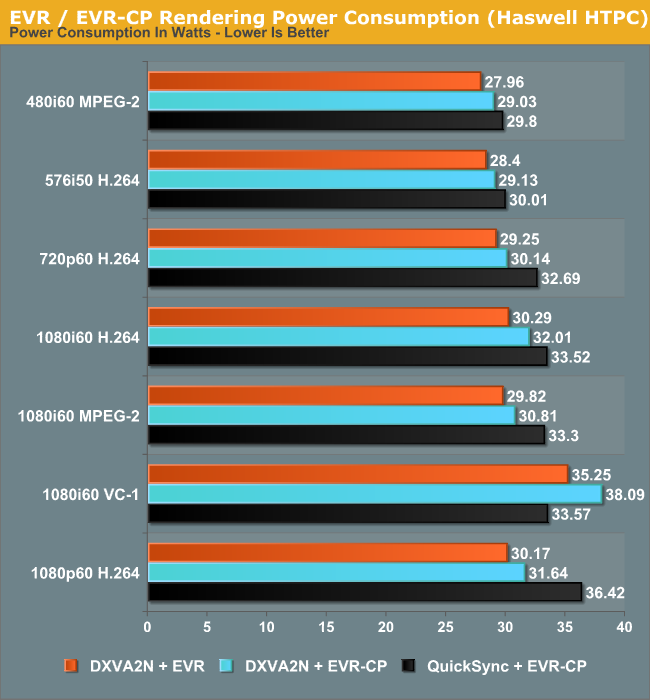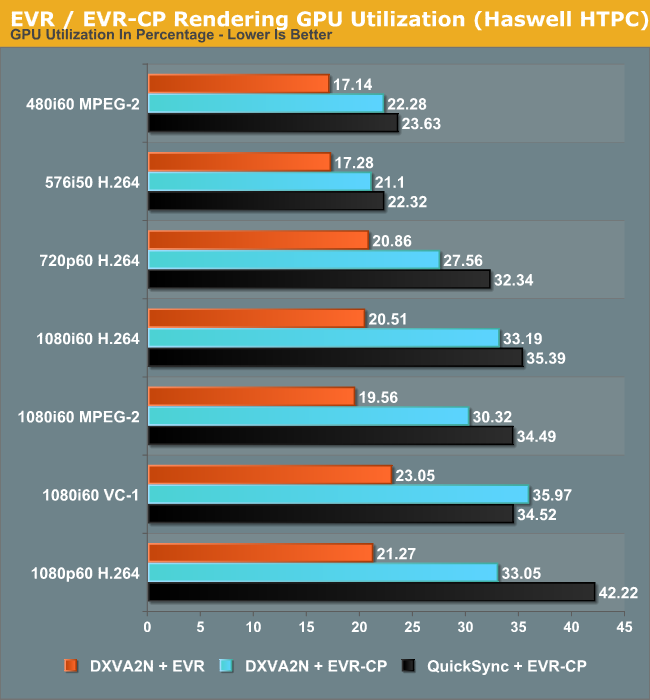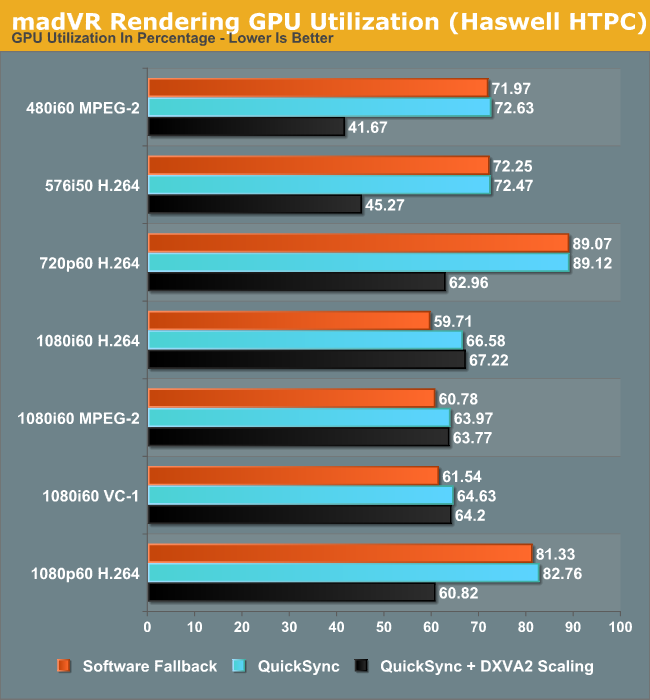Intel's Haswell - An HTPC Perspective: Media Playback, 4K and QuickSync Evaluated
by Ganesh T S on June 2, 2013 8:15 PM ESTDecoding and Rendering Benchmarks
Our decoding and rendering benchmarks consists of standardized test clips (varying codecs, resolutions and frame rates) being played back through MPC-HC. GPU usage is tracked through GPU-Z logs and power consumption at the wall is also reported. The former provides hints on whether frame drops could occur, while the latter is an indicator of the efficiency of the platform for the most common HTPC task - video playback.
Enhanced Video Renderer (EVR) / Enhanced Video Renderer - Custom Presenter (EVR-CP)
The Enhanced Video Renderer is the default renderer made available by Windows 8. It is a lean renderer in terms of usage of system resources since most of the aspects are offloaded to the GPU drivers directly. EVR is mostly used in conjunction with native DXVA2 decoding. The GPU is not taxed much by the EVR despite hardware decoding also taking place. Deinterlacing and other post processing aspects were left at the default settings in the Intel HD Graphics Control Panel (and these are applicable when EVR is chosen as the renderer). EVR-CP is the default renderer used by MPC-HC. It is usually used in conjunction with MPC-HC's video decoders, some of which are DXVA-enabled. However, for our tests, we used the DXVA2 mode provided by the LAV Video Decoder. In addition to DXVA2 Native, we also used the QuickSync decoder developed by Eric Gur (an Intel applications engineer) and made available to the open source community. It makes use of the specialized decoder blocks available as part of the QuickSync engine in the GPU.

Power consumption shows a tremendous decrease across all streams. Admittedly, the passive Ivy Bridge HTPC uses a 55W TDP Core i3-3225, but, as we will see later, the power consumption at full load for the Haswell build is very close to that of the Core i3-3225 build despite the lower TDP of the Core i7-4765T.
In general, using the QuickSync decoder results in a higher power consumption because the decoded frames are copied back to the DRAM before being sent to the renderer. Using native DXVA decoding, the frames are directly passed to the renderer without the copy-back step. The odd-man out in the power numbers is the interlaced VC-1 clip, where QuickSync decoding is more efficient compared to 'native DXVA2'. This is because there is currently no support in the open source native DXVA2 decoders for interlaced VC-1 on Intel GPUs, and hence, it is done in software. On the other hand, the QuickSync decoder is able to handle it with the VC-1 bitstream decoder in the GPU.

The GPU utilization numbers follow a similar track to the power consumption numbers. EVR is very lean on the GPU, as discussed earlier. The utilization numbers provide proof of the same. QuickSync appears to stress the GPU more, possibly because of the copy-back step for the decoded frames.
madVR
Videophiles often prefer madVR as their renderer because of the choice of scaling algorithms available as well as myriad other features. In our recent Ivy Bridge HTPC review, we found that with DDR3-1600 DRAM, it was straightforward to get madVR working with the default scaling algorithms for all materials 1080p60 or lesser. In the meanwhile, Mathias Rauen (developer of madVR) has developed more features. In order to alleviate the ringing artifacts introduced by the Lanczos algorithm, an option to enable an anti-ringing filter was introduced. A more intensive scaling algorithm (Jinc) was also added. Unfortunately, enabling either the anti-ringing filter with Lanczos or choosing any variant of Jinc resulted in a lot of dropped frames. Haswell's HD4600 is simply not powerful enough for these madVR features.
It is not possible to use native DXVA2 decoding with madVR because the decoded frames are not made available to an external renderer directly. (Update: It is possible to use DXVA2 Native with madVR since v0.85. Future HTPC articles will carry updated benchmarks) To work around this issue, LAV Video Decoder offers three options. The first option involves using software decoding. The second option is to use either QuickSync or DXVA2 Copy-Back. In either case, the decoded frames are brought back to the system memory for madVR to take over. One of the interesting features to be integrated into the recent madVR releases is the option to perform DXVA scaling. This is particularly interesting for HTPCs running Intel GPUs because the Intel HD Graphics engine uses dedicated hardware to implement support for the DXVA scaling API calls. AMD and NVIDIA apparently implement those calls using pixel shaders. In order to obtain a frame of reference, we repeated our benchmark process using DXVA2 scaling for both luma and chroma instead of the default settings.

One of the interesting aspects to note here is the fact that the power consumption numbers show a much larger shift towards the lower end when using DXVA2 scaling. This points to more power efficient updates in the GPU video post processing logic.

DXVA scaling results in much lower GPU usage for SD material in particular with a corresponding decrease in average power consumption too. Users with Intel GPUs can continue to enjoy other madVR features while giving up on the choice of a wide variety of scaling algorithms.










95 Comments
View All Comments
mindbomb - Sunday, June 2, 2013 - link
The current version of madvr does support dxva native actually.gevorg - Sunday, June 2, 2013 - link
The near $300 price of i7-4765T is extremely price prohibitive for HTPC use. Majority of users will find AMD's Trinity APUs to be perfect for HTPC job.Also, unless Intel handicapped it, you should be able to downclock any i7 Haswell CPU to be near i7-4765T speed/TDP. This is possible with Sandy Bridge and Ivy Bridge chips.
meacupla - Sunday, June 2, 2013 - link
the only problem with trinity is the rather limited choice of mITX mobos and rather high power consumption and thermal output, which makes them not ideal for compact HTPCs...Although, granted, for $300 for the CPU alone, I'd much rather buy an xboxone or PS4.
HisDivineOrder - Tuesday, June 4, 2013 - link
You just listed four problems while saying, "the only problem with trinity." That's the real problem with AMD's options. There's like "one problem" for everyone.Spunjji - Tuesday, June 4, 2013 - link
Except for those of us for whom there are none, and/or are prepared to live with limitations to not have to shell out $300 on a CPU.vnangia - Sunday, June 2, 2013 - link
Very true. The SNB low-TDP parts were within spitting distance of their equivalent regular-TDP parts (about $25-50 more), not $200 more.JDG1980 - Sunday, June 2, 2013 - link
If you can wait six months or so, you're probably going to be better off going with Kaveri. AMD is going to be substantially increasing the GPU power of their APU and switching to a homogenous memory architecture so everything uses GDDR5. What little I've heard (which may not be reliable) seems to indicate that the GPU in Kaveri may be about on par with the discrete 7750. I don't know if they can pull that off, but if they even come close then they will have basically rendered all sub-$100 discrete GPUs obsolete.lmcd - Sunday, June 2, 2013 - link
Inaccurate. $100 GPUs will have improved by Kaveri's release. And AMD's drivers won't necessarily meet the expectations set here either.medi02 - Monday, June 3, 2013 - link
This driver FUD is getting old...Spunjji - Tuesday, June 4, 2013 - link
Very old, but don't expect it to stop.